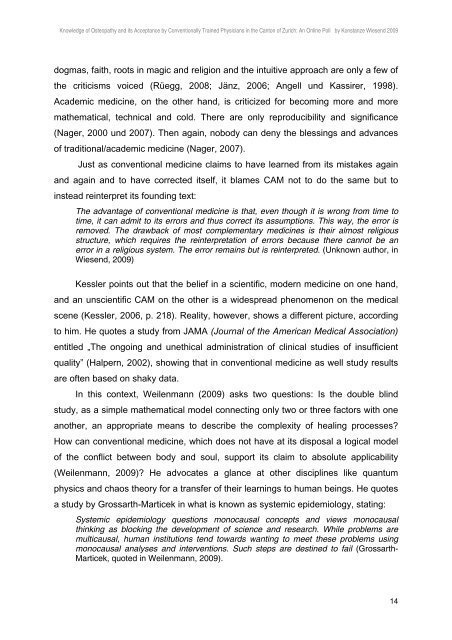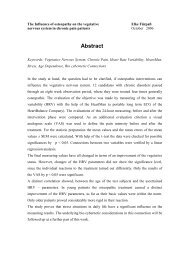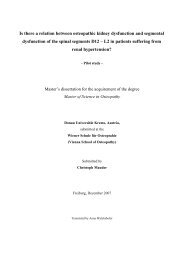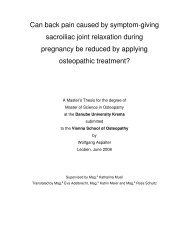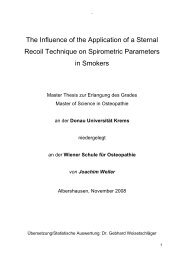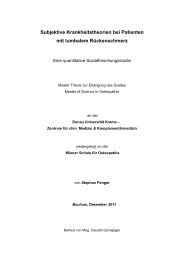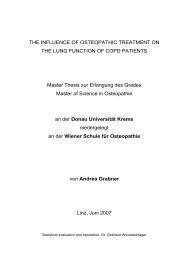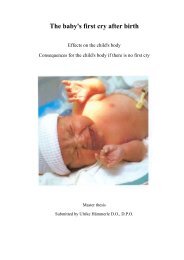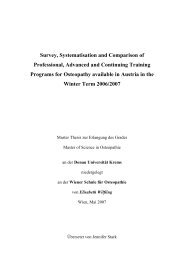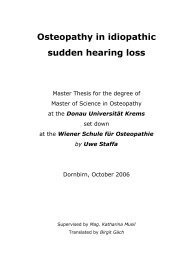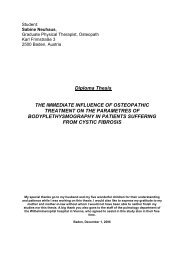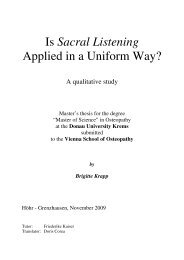Schulmedizin – Osteopathie - Osteopathic Research
Schulmedizin – Osteopathie - Osteopathic Research
Schulmedizin – Osteopathie - Osteopathic Research
Sie wollen auch ein ePaper? Erhöhen Sie die Reichweite Ihrer Titel.
YUMPU macht aus Druck-PDFs automatisch weboptimierte ePaper, die Google liebt.
Knowledge of Osteopathy and its Acceptance by Conventionally Trained Physicians in the Canton of Zurich: An Online Poll by Konstanze Wiesend 2009<br />
dogmas, faith, roots in magic and religion and the intuitive approach are only a few of<br />
the criticisms voiced (Rüegg, 2008; Jänz, 2006; Angell und Kassirer, 1998).<br />
Academic medicine, on the other hand, is criticized for becoming more and more<br />
mathematical, technical and cold. There are only reproducibility and significance<br />
(Nager, 2000 und 2007). Then again, nobody can deny the blessings and advances<br />
of traditional/academic medicine (Nager, 2007).<br />
Just as conventional medicine claims to have learned from its mistakes again<br />
and again and to have corrected itself, it blames CAM not to do the same but to<br />
instead reinterpret its founding text:<br />
The advantage of conventional medicine is that, even though it is wrong from time to<br />
time, it can admit to its errors and thus correct its assumptions. This way, the error is<br />
removed. The drawback of most complementary medicines is their almost religious<br />
structure, which requires the reinterpretation of errors because there cannot be an<br />
error in a religious system. The error remains but is reinterpreted. (Unknown author, in<br />
Wiesend, 2009)<br />
Kessler points out that the belief in a scientific, modern medicine on one hand,<br />
and an unscientific CAM on the other is a widespread phenomenon on the medical<br />
scene (Kessler, 2006, p. 218). Reality, however, shows a different picture, according<br />
to him. He quotes a study from JAMA (Journal of the American Medical Association)<br />
entitled „The ongoing and unethical administration of clinical studies of insufficient<br />
quality” (Halpern, 2002), showing that in conventional medicine as well study results<br />
are often based on shaky data.<br />
In this context, Weilenmann (2009) asks two questions: Is the double blind<br />
study, as a simple mathematical model connecting only two or three factors with one<br />
another, an appropriate means to describe the complexity of healing processes?<br />
How can conventional medicine, which does not have at its disposal a logical model<br />
of the conflict between body and soul, support its claim to absolute applicability<br />
(Weilenmann, 2009)? He advocates a glance at other disciplines like quantum<br />
physics and chaos theory for a transfer of their learnings to human beings. He quotes<br />
a study by Grossarth-Marticek in what is known as systemic epidemiology, stating:<br />
Systemic epidemiology questions monocausal concepts and views monocausal<br />
thinking as blocking the development of science and research. While problems are<br />
multicausal, human institutions tend towards wanting to meet these problems using<br />
monocausal analyses and interventions. Such steps are destined to fail (Grossarth-<br />
Marticek, quoted in Weilenmann, 2009).<br />
14


